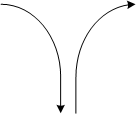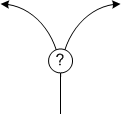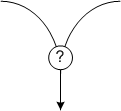
Home | About | Contacts | Latest News | Coming Events

Currently, most traffic around the Rockery is through traffic. To understand the typical interactions between these cars, think of them as heading in one of the following six directions around the Rockery triangle. (NOTE: These sketches all use the same orientation as the satellite maps.)

At the intersections formed by these three corners of the Rockery, there are a total of six traffic behaviors that can be classified as "easy turns":
 "overlap" |  "split" |  "merge" |  "cross" |
 "nose out" |  "race" |
The set of easy turns begins with the "overlap", where cars heading northwest on Main overlap with cars heading southwest from Main onto Lincoln. This is only worth mentioning for the sake of completeness.
A more important intersection behavior is the "split", where you have two or more cars heading south on Main. From all other vantage points around the Rockery, it's effectively impossible to tell in advance whether a given car will split right (to go west via Barrows to Lincoln) or left (to continue on Main). There's no obvious right-of-way, cars speed about as much in both directions, and turn signal usage is unfortunately considered optional by most.
The opposite of the split is the "merge", where cars headed northeast on Barrows from Lincoln and cars headed northeast from Main or Center converge at the same spot. Driving behavior at this intersection depends greatly on whether anyone's parked in the head-in spots at the Rockery. If not, then visibility is generally good enough that the cars can merge without slowing down. Yet when anyone's parked at the Rockery, visibility is greatly reduced, and one or both cars need to slow down to see who's really ahead.
The true significance of the split becomes apparent when you consider the "cross", where cars headed northeast on Barrows from Lincoln have to slow down to see which way oncoming traffic headed south on Main will choose to go at the split.
Of these easy turns, the most dangerous for drivers is probably the "nose out", where cars coming southwest from Main on Barrows need to stop before merging into westbound traffic on Lincoln. Given the topology of that intersection, many drivers feel they need to edge their noses uncomfortably far out into the intersection, or else they won't have an adequate chance to the judge the speed of the westbound traffic accelerating uphill on Lincoln. Even worse, approximately one-fourth of these drivers -- who've already accelerated uphill along Barrows to the intersection -- don't make a full stop before continuing. Is it any wonder there've been two fatal accidents at this intersection in the past twenty years?
Finally, we have the "race", where eastbound traffic on Lincoln needs to make a left turn down Barrows towards Main in the face of oncoming westbound traffic. While the speed of traffic through this stretch of Lincoln is a major contributing factor to problems at this intersection, that's not what this name represents. There's a prominent crosswalk here, and visibility for pedestrians crossing Lincoln to the north is barely adequate.
However, safe pedestrian crossing in the opposite direction (to the south) is another story entirely. Even if you nose out like drivers do to see what's happening with westbound traffic, that still doesn't help enough. Unfortunately, the geometry is such that you simply can't see the eastbound traffic speeding along until it's right there. Thus, pedestrians who wish to cross to the south tend to resort to one of the following two strategies: 1. nose out and hope an eastbound driver sees you waiting, stops, and lets you cross, or 2. "run, don't walk". This latter strategy is especially hazardous.
However, for anyone who needs to safely park in or near the Rockery, there are a much more dangerous set of "hard turns" that must be mastered.